 On April 14, 2012, Nickelodeon premieres one of the most eagerly-anticipated new series, THE LEGEND OF KORRA. This is the next chapter of the epic saga that began with AVATAR: THE LAST AIRBENDER. The original series ran from 2005 to 2008 and won critical acclaim, a massive fanbase and numerous awards including two Emmys and five Annies (the Annie awards honor animation). Not to be confused with James Cameron's 3D blockbuster AVATAR, AVATAR: THE LAST AIRBENDER was an animated tale of the adventures of four friends in a world where some people are born with the ability to manipulate - or bend - the elements of air, water, earth and fire. Only the Avatar can bend all four. Kung fu fans of the original series were struck by how well the Chinese martial arts were represented. For anyone with a passing knowledge of kung fu and tai chi, the fight scenes, the ancient weapons and the magical bending gestures were clearly based on actual traditional styles. This was the work of Sifu Kisu of the Harmonious Fist Chinese Athletic Association.
On April 14, 2012, Nickelodeon premieres one of the most eagerly-anticipated new series, THE LEGEND OF KORRA. This is the next chapter of the epic saga that began with AVATAR: THE LAST AIRBENDER. The original series ran from 2005 to 2008 and won critical acclaim, a massive fanbase and numerous awards including two Emmys and five Annies (the Annie awards honor animation). Not to be confused with James Cameron's 3D blockbuster AVATAR, AVATAR: THE LAST AIRBENDER was an animated tale of the adventures of four friends in a world where some people are born with the ability to manipulate - or bend - the elements of air, water, earth and fire. Only the Avatar can bend all four. Kung fu fans of the original series were struck by how well the Chinese martial arts were represented. For anyone with a passing knowledge of kung fu and tai chi, the fight scenes, the ancient weapons and the magical bending gestures were clearly based on actual traditional styles. This was the work of Sifu Kisu of the Harmonious Fist Chinese Athletic Association.
I've known Kisu for many years as we are martial cousins within the Bak Sil Lum system. Bak Sil Lum, which means Northern Shaolin in Cantonese, is attributed to a legendary hero named Gan Fengchi. Prior to the restoration of the Songshan Shaolin Temple, Bak Sil Lum was the dominant style of Shaolin kung fu outside of China. Kisu's influence on the look and feel of THE LAST AIRBENDER is quintessential, because as we all know, in an action epic, it's all about the fight scenes. His contribution had so much impact that he was even immortalized within the AVATAR world as the swordmaster Piandao. Piandao taught jian to the only one of the four heroes who couldn't bend, the comic yet noble Sokka. It was a delight to catch up with my old kung fu cousin and get the scoop on THE LEGEND OF KORRA.
![]() GC: How does it feel to be a cartoon character?
GC: How does it feel to be a cartoon character?
K: Well, I guess you're referring to the Piandao character. It was really quite flattering, I have to say. Being a big fan of animation and cartoons, and a big kid at heart my entire life, I was really flattered when they came up with such a powerful and cool great example of a human being in terms of his philosophies and his demeanor. It's just awesome.
I get ribbed about it a little bit.
GC: What do your masters think about it ?
K: My teacher, at our Christmas party, with a lot of pride in his voice, announced, when I did a demo for the Christmas party - that's how we celebrate Christmas; everyone does a kung fu form - he explained to everyone that I was responsible for the martial arts in this show that he's very proud of. We took him to the premiere at Nickelodeon animation. He's always been suspect about kung fu and how it's portrayed in popular media. He watched the first three or four episodes - the boy in the iceberg - and he was teary eyed. He said, 'You did good. It represented martial arts in a very positive and beautiful light in terms of its restraint and its philosophy.' He really enjoyed the AVATAR and the way the martial arts were showcased.
GC: For the sake of our readers, tell us about your martial background.
K: My background is pretty simple actually. I began studying karate when I was very young with my uncles when they came back from Vietnam. They were into jujitsu and karate. They sent me off to a family friend in St. Louis who did Shorin- ryu, a guy by the name of Robert Yarnell. He produced some pretty amazing people over his time period. After him, I got involved with taekwondo - the Chung Do Kwan system - and had the great fortune to study with Master Kong Eng Moo who was in the first class with Hee Il Cho and Jhoon Rhee. He was in that very first class of taekwondo-ers. It was a beautiful experience. I got to travel with him to the headquarters in Korea, the Kukkiwon.
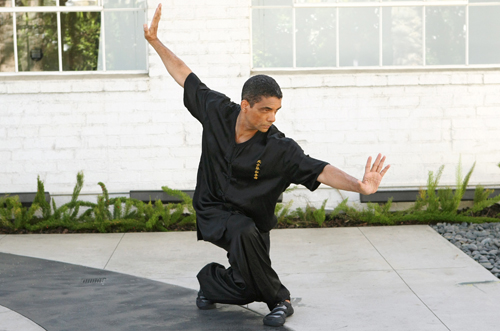
GC: I never knew that. When was that ?
K: Back in the '70s - the late '70s. I studied with him at Schofield Barracks in Hawaii when I was in the military there. I went back and forth with him and he was good friends with the Korean president around that time, Park Chung-hee, that got assassinated. I got the chance to hang out with him and his bodyguards, who were all heavy taekwondo people. That was a really cool experience.
And then I met my current teacher in 1980, Master Kenneth Hui. There's so much to say about him. He's like my father. He's the primary exponent in southern California representing the Worldwide Northern Shaolin Kung Fu Association. He studied the complete curriculum of styles from Master Johnny So. I've got a wide group of classmates who are his disciples who teach throughout Southern California according to his values and principles.
I don't know if you know that my teacher is a professional aerospace engineer. He holds some technological achievements; he created some pretty heavy stuff for the military industrial sector. He holds several advanced degrees in business and engineering from USC and UCLA and his background allows him to correlate and apply modern scientific knowhow to validate the ancient teachings of real traditional kung fu. He continually focuses on the further expansion and teaching of traditional kung fu as a means of raising awareness of the ancient Chinese values and wisdom for personal growth, health development and the martial arts among the communities. We've been friends and family for a long time.
GC: To get back to AIRBENDER, what does your kid think about you being Piandao ?
K: It's been an interesting experience with my son from the beginning because he's had AVATAR notebooks, pictures and T-shirts and all that stuff before anyone even knew or heard of AVATAR. When the series came out, he tried to tell a few people that his dad was involved with it. You know how kids are. They were being really mean. But he's very proud. He gets ecstatic when he talks to other children that his dad played an influential role and that his dad is a cartoon character (laughs). It's fortunate that I'm not something goofy. I'm not some balloon man or something. (laughs again) He gets a lot of kicks hearing the excitement and the positive feedback from his peers and seeing me showcased on the Nickelodeon interstitials and special features.
I've had a couple of experiences being out in public at tournaments and what-not and it's been really interesting how people perceive my association with martial arts and the cartoon. A couple of people have made barbs with it, but overall, it's been very positive. I've gotten emails and letters from all over the world from traditional teachers who say, "We've got children in our tai chi class. We've never had children in a tai chi class. Thank you.'" It's been a big shot in the arm for martial arts at large.
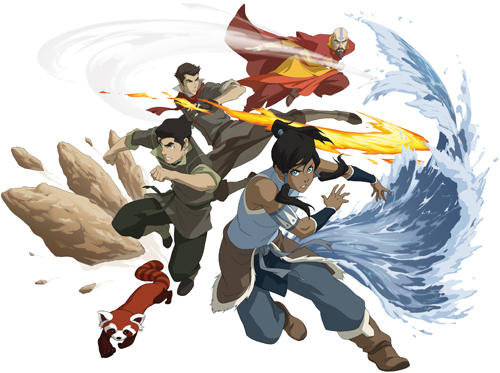
GC: I know you've discussed this many times in interviews and special features, but for the sake of those who don't know AIRBENDER, describe how the four bender styles tie to traditional kung fu styles.
K: Ah. It's actually pretty simple. Everything I am goes back to my learnings from my teacher. I cheated a little bit. I took and borrowed from our curriculum the techniques that my teacher emphasizes the most. Your Northern Shaolin teacher, Wing Lam, is the same - he's a hung gar exponent too - a high level practitioner of the hung gar style.
GC: That's right.
K: When Bryan (Konietzko) started talking to me about the four elements, it immediately came to me that hung gar with its low stances, its rooted power, its strength - the way that the guys went when they do the iron wire set - the different qigongs, they blow up with these massive muscles. It just spoke to me that that should be an earth style. So we used a lot of the techniques from gung gee fook fu - taming the tiger form - and the tiger crane form. The process of the show is we'll have a particular "bending," a series of antics that go along with a particular technique of a particular style. I go back through my head to the particular training elements that relates. In our Chinese martial arts, there's a five element theory, which works in cycles of promotion.
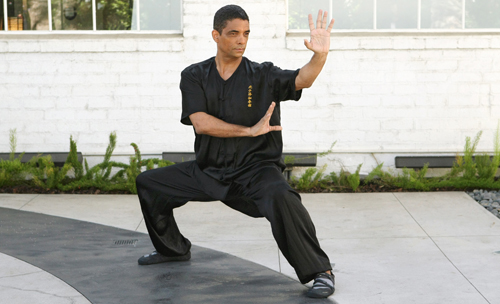
GC: And destruction.
K: Yeah, there's like a paper-scissors-rock effect. So it was rather easy to do that. I have some close friends in hung gar. Sifu Don Hamby, who is here in Los Angeles, has shared some of the hung gar and I got some notes from him. I'm a poor vessel for that style, but you know, we try to be honest and clear, without misrepresenting any of the techniques.
Tai chi and its fluidity and its connectiveness and its adaptability was perfect for the water bending styles. They did some really cool stuff with the 24-Step form, creating the water bending scroll that Katara ended up with at one point with the pirates. It was so cool. We mixed so much lore from Chinese culture and Chinese martial arts culture, which are two big separate entities. Chinese martial culture has its own language, its own characters, its own codifications, right ?
GC: Absolutely.
K: So that was really beautiful to do that.
Fire, of course, the bad guys. Things were falling out of balance and they were dominating the land. I had to get our Northern Shaolin system in there somewhere.
GC: I loved Zuko's flame daggers. That comes straight out of our Bak Sil Lum double dagger form.
K: Exactly! That's exactly it. There are specific pieces of choreography. It's funny because what we would do in terms of choreographing it was we'd have a fight, and it was so easy. I could take a segment from a particular strand. There are actually wholesale pieces in which my thought was to get these guys to illustrate our boxing, which I don't think had ever been done in that beautiful light there. There's a lot of drawings from a lot of shows. I have stacks and stacks of copies of the reference material that went into it - DVDs, VHS tape - so much material, so much work. We created a "bending bible" before we even got sixth months into production of the first season. It's as long as my fingertip to my wrist. It's that thick.
In particular, I thought Northern Shaolin would be great for fire because fire has many manifestations. When it's controlled, it's one way. When it's out of control, it's something else. I thought Northern Shaolin would lend itself really well to that sort of thing. As a system of domination for war, it has some deep-rooted history in that. It has techniques from styles outside of China, like chaquan, which is the northern Islamic fist, the wahquan and paoquan. Most martial arts styles emphasize specific characteristics and techniques or philosophies from theories. Northern Shaolin is unique in that it is an overall encompassing system that is well-rounded and covers many aspects of the training in terms of all fighting ranges: long, medium and short. It covers the applications using all parts of the body as weapons and tools without a biased for any particular one. It's not just kicking or just grappling.
Most kung fu systems are developed to enhance the inventor's specialty, or more important, to cover the inventor's weakness. For example, wing chun was made for a woman to compensate for her size and strength against a man. Also, praying mantis was a small man who was beaten by his larger classmates and adapted the techniques of the praying mantis. The most difficult aspects of martial arts aren't covered by many styles, which are the aspects of speed, agility, mobility, power and the long range fighting - cover that gap. Just because Northern Shaolin is so broad, it covered these aspects fully. It actually became famous for those specialties.

From my personal insight, Northern Shaolin is the unique body mechanics, the footwork which is very powerful and dynamic, intricate footwork and arrow-like forward attacking techniques, feather-like retreating skills that bounce out of range then comes back in - light as a leaf, heavy as iron - and the broad variety of hand and kicking technique. Those are illustrated and carried forth in a serious of core techniques and forms. The Shaolin 18 hands covers all the critical application techniques except that doesn't cover some specifics of Northern Shaolin - the leg maneuvers and kicking techniques that are the key representations of our style. I think the system is mainly built on the core techniques that rise from lin bo, the training form - the linking steps, and tan toy, the stabbing kicks, which is a connection with the cha. The Shaolin 18 hands is the Rosetta Stone in my personal opinion of Northern Shaolin. It ties each of the forms. Am I going on too much ?
GC: No, I'm with you. Remember, I'm a Northern Shaolin guy too.
K: I know. I'm very close with your teacher. You've travelled a great deal and you're one of my inspirations, brother. I've followed your writings and your antics for thirty years.
GC: Thanks, but this is about you now.
K: It's true! I'm sorry. It was sincere.
In my experience of Northern Shaolin, not being Chinese, my teacher taught very openly. He didn't care [about] your race or anything. As long as you worked hard and as long you weren't disruptive and weren't too stupid to learn, he taught you. I learned a lot of Cantonese as a by-product of it. But still, we are not Chinese. You're always outside of any culture that isn't your cradle language that you aren't raised in. He didn't really give us the applications, the fighting techniques. So that's how we formed our Harmonious Fists group. It was actually several of my classmates who got together. That was our laboratory for the techniques for Northern Shaolin. We went and we experimented on how to apply them. It struck my teacher as really strange. He said, "I didn't teach you guys how to use this stuff." This was probably ten to fifteen years into my instruction with him. We started playing with it - finding out how it worked against people that wrestled, people that boxed, people that were good kickers - the four skills: punch, kick, grab, throw. That was a very unique experience in itself to actually have the opportunity to go out and test it and come back with your life. (laughs) Did I answer your question ?
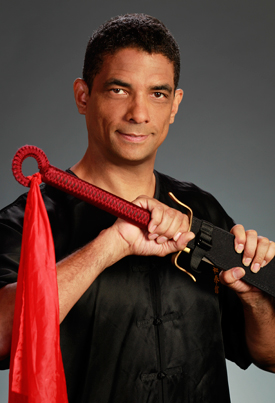 GC: Air. Air bending is based on bagua, right ?
GC: Air. Air bending is based on bagua, right ?
K: Thank you. The Aang character, he was really gentle and non-confrontational. This really led me to bagua because bagua's circle walking technique acts and reacts to what the opponent does to you. The opponent delivers a vector of force and if it touches your center, you spin your center so it can't affect you center of mass. And then when the opponent becomes static, you walk around the opponent until you find an opening. It's basically an 8-step clock around a center point. That lent itself very well to air bending. It's part of our curriculum that my teacher taught us - palm change bagua. At that particular time, I was just learning it. I can't say that I was a very good representative. My primary thrust is Northern Shaolin. I don't claim to be an expert. I just practice, practice, practice, practice.
GC: So now with KORRA, will we see any new styles ? I saw a leaked clip that had metal bending.
K: Indeed we are. Mac Danzig and Jeremy Umphries are MMA guys. Mike became a big fan of UFC and MMA fighting, which influences the "pro bending" in the series. It's more or less an octagon. It lends itself to some pretty fun stuff. Then they brought in two young men who do aerial acrobatic martial arts. I think they call it "tricking." Steve Terada and Jake Huang are their names. They were doing some really fantastic aerial techniques, spinning their center. It's stuff I did when I was 18. In case people wonder, I'm 53 now. Northern Shaolin has lent itself to my longevity. I'm still flexible. I'm still mobile. Many systems don't lend themselves to that. I mean, how many old Muay Thai boxers do you see out there ? It's helped as a lifelong pursuit that my body has adapted through the ages. I've overcome various types of disabilities and what not through that. But I've strayed from the question again.
Metal bending. Yes. Interesting you would say that. Metal bending is an outgrowth of Toph. Actually, it's Toph's daughter who is head of the metal bending police. Toph's style was taken from my dear friend Sifu Manuel Rodriguez, of the Chu Gar Southern Praying Mantis system. It's funny because he's a pretty big guy, so they wanted someone smaller to do the Toph movements - to demonstrate the reference for it. And then they brought in his son, Scott A. Logan - he wasn't credited in the series. But it was his son that demonstrated the different manifest energies for the Toph character. So the metal bending police are using some of those techniques for reference. But they do kind of like a SWAT team sort of thing, so I actually choreographed some entry techniques based on some elements I learned when I was in the military in terms of fire, ranging, covering sectors and vectoring that sort of thing. We did some fun stuff with the metal bending police. The way that they land from a drop is really unique and cool and kind of eerie. I'm bursting to tell you. Some of the fights are unexpected and mind blowing. So the metal bending is an outgrowth of that over the years. It's Chu Gar based with modern military techniques thrown in there.
GC: We'll look forward to that.
K: Azula we took from the chaquan system. For the fire lightning, I used some of the movements from Shaolin form number two - dragon shoots its whiskers. Ozai, when he tried to kill Zuko, that was the technique from Shaolin #2.
GC: I never put that together before, but I can totally see what you're talking about. How does choreographing animation compare to choreographing film ?
K: I've choreographed film and that's a very interesting process that in the end depends on your actors and your stunt people when they get out there. Your actor gets the beats right; your stunt team sells the hits. Whereas in animation, it's just been a really cool experience. I love kung fu movies. I'm a big fan of Jackie Chan and Jet Li. Gordon Liu. All those old films. I loved SHAOLIN VS. WUDANG and FIVE SUPER FIGHTER, all those really cool old movies that filled me with such passion for martial arts. Of course, Bruce Lee. When it comes to animation, you have absolute control of everything. So it's perfectly detailed. We wanted to emphasize with the bending that it had a process. It came from somewhere and went to somewhere, like your gongs and qigong. Things start from your breath - the opening and closing of the center. For the animators, they found it was very difficult to animate someone breathing. It's little things that we take for granted. But like Combustion Man, who almost didn't move and he'd blow something up. That was really cool because I got a chance to do some of the breath stuff I've been talking about.
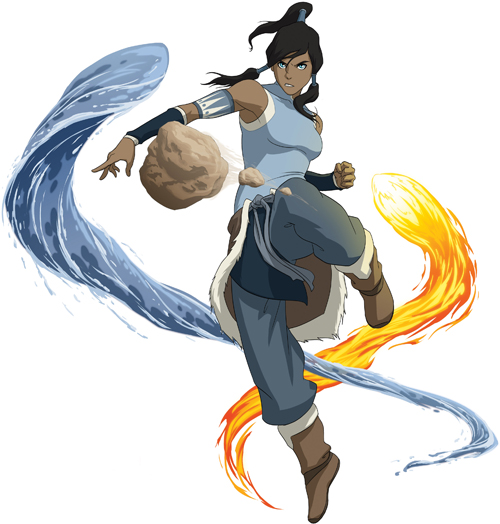
When we choreograph a show, it's a team process. They'll come up with a particular bending, and then I'll pitch a series of movements that I think would be good for manifesting that particular type of bending. Like if there's an earth bending technique and it calls for pieces of earth to come up at an angle, we'd do something like a forward arrow shooting leg. We'd create an antic that would coincide. There's been some shows that have tried to do martial arts magic sorts of things and I think one of the things that didn't come across was that the antic didn't match the effect. Throughout the series, like when we had the little Toph character fighting the big WWF characters and all of their bravado - and a little tiny blind girl was taking them out. It was so cool to use the unique antics of Southern Praying Mantis, the hand forms and whatnot. You could totally see the movement and the manifestation. In real kung fu, there's the movement and the intention behind the movement and then the actual manifest energy as it affects the opponent.
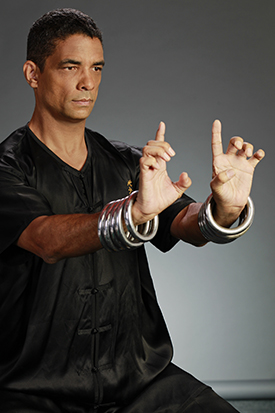 GC: Right. There's a whole energetic level to kung fu that's very unique to each style.
GC: Right. There's a whole energetic level to kung fu that's very unique to each style.
K: Right. We've really got into that into the show.
GC: Will there be more traditional Chinese weapons ? I loved seeing Tiger Hooks and Butterfly Knives in AVATAR.
K: You're not going to see as much, but it's possible. There's a lot of cool surprises. The show is about self-confidence, self-empowerment, friendship, discipline, respect - some of the core values that we had a chance to bring across in AVATAR. I think it instills in children particularly that you can learn anything through a series of core basics. And then when those basics are refined, you can take that anywhere. Most people are sitting around waiting for a free lunch. The bottom line is that if you do the proper amount of work, you can do anything. You can be anyone. I think that's a powerful message that the show says.
And then the artwork is fantastic. There's such an amazing team of ultra-talented people that are doing this. We've got 26 episodes ordered so far. The fans won't be disappointed. The kung fu community won't be disappointed. There's going to be some unique weapons in this - steampunk technology. It's the time of the first internal combustion engine. Electricity is a big hot ticket. There's going to be some cool stuff with electricity.
Man, I got to be careful what I can say because I don't want to spoil it for the fans. Officially, THE LEGEND OF KORRA brings the world of Avatar to a more modern time. The series follows the new Avatar. She's 17 years old. She's a headstrong rebellious girl. She continually challenges and bucks tradition in her quest to become the Avatar. I think, in the end, tradition goes full circle.
If you liked AVATAR, you're going to love KORRA. That's all I can tell you.
About
Gene Ching :
![]() For more on The Legend of Korra, visit . Sifu Kisu portaits are courtesy Robert Voets/Nickelodeon. THE LEGEND OF KORRA artwork provided by Nickelodeon. ©2012 Viacom, International, Inc. All Rights Reserved.
For more on The Legend of Korra, visit . Sifu Kisu portaits are courtesy Robert Voets/Nickelodeon. THE LEGEND OF KORRA artwork provided by Nickelodeon. ©2012 Viacom, International, Inc. All Rights Reserved.
![]() Print Friendly Version of This Article
Print Friendly Version of This Article
















